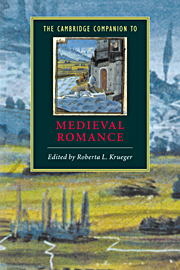Book contents
- Frontmatter
- Introduction
- Part 1 The origins, forms, and contexts of medieval romance
- Part 2 European romance and medieval society
- Part 3 European transformations
- 10 The evolution and legacy of French prose romance
- 11 Medieval German romance
- 12 Chivalry and medieval Italian romance
- 13 Gawain and popular chivalric romance in Britain
- 14 Middle English romance
- 15 Romance at the crossroads
- Editions and translations
- Index
- Series list
13 - Gawain and popular chivalric romance in Britain
from Part 3 - European transformations
Published online by Cambridge University Press: 28 May 2006
- Frontmatter
- Introduction
- Part 1 The origins, forms, and contexts of medieval romance
- Part 2 European romance and medieval society
- Part 3 European transformations
- 10 The evolution and legacy of French prose romance
- 11 Medieval German romance
- 12 Chivalry and medieval Italian romance
- 13 Gawain and popular chivalric romance in Britain
- 14 Middle English romance
- 15 Romance at the crossroads
- Editions and translations
- Index
- Series list
Summary
The earliest texts that preserve stories of Gawain present him not as a popular hero, but as a traditional champion. Tales in the Welsh Mabinogion, and scattered allusions from other Celtic works, suggest that Gawain was well-established in oral narratives as the nephew, companion, and defender of the great king. Welsh translations of Geoffrey of Monmouth’s Latin History of the Kings of Britain confirm this match of Walwanus (Gawain) and Gwalchmai mab Gwyar, a man of action around whom adventures swirled, a renowned figure about whom audiences wished to hear more. Behind these earliest surviving stories there may lurk traces of divinity or superhuman stature, linking Gawain to solar heroes whose strength surges before noon, and wanes with the setting sun. Despite his stature and centrality in Celtic tradition, Gawain was scarcely “popular” in the sense of being available to diverse constituencies or multiple genres. Nonetheless, by the early twelfth century his fame seems to have spread far beyond the audiences for traditional oral narratives, making him a familiar figure in European ecclesiastical and learned culture. The cosmopolitan appeal of Arthurian story emerges early in a sculpture (dated before 1109) at the Cathedral in Modena, Italy; this depicts Gawain undertaking a siege, together with Arthur and two other knights.
- Type
- Chapter
- Information
- The Cambridge Companion to Medieval Romance , pp. 218 - 234Publisher: Cambridge University PressPrint publication year: 2000
- 1
- Cited by



